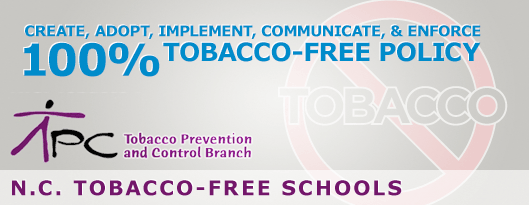


Note: This site documents N.C.’s work on making public schools tobacco free, from 2000 until state law went into effect in 2008, and is provided as a resource for states and communities currently working to make their schools tobacco free. Factual information reflects research and data from 2000-2008.
As school districts across North Carolina explore the merits of adopting and enforcing a 100% Tobacco Free Schools policy, the question has been raised, “will this really reduce youth tobacco use?” Can a tobacco-free policy, when enforced, make a difference? A look at key research studies and recommendations from science-based organizations, can provide data for those who need more evidence to support a school tobacco ban.
It is well established that tobacco use is the leading preventable cause of death and disease in the U.S. and that over 80% of adult users started before age eighteen. 3,000 young persons begin smoking daily. Reasons that kids start smoking or chewing are multi-faceted. Influences come from parents, teachers, coaches and other adults, peers, mass media, and price/availability of tobacco products. Because the influences are so many, efforts to reduce tobacco use must include more than one strategy.
An extensive body of research documented in the Surgeon General’s Report, Reducing Tobacco Use, shows that comprehensive school-based programs, combined with community and mass-media efforts, can effectively prevent or postpone smoking onset by 20 to 40 percent among U.S. teens.
A description of “comprehensive school based programs” is defined by the Centers for Disease Control, in their Guidelines for School Health Programs to Prevent Tobacco Use and Addiction. Of the seven guidelines, the first one recommends that schools develop and enforce policies on prohibiting tobacco use by students, staff, parents and visitors on school grounds. The other guidelines include K-12 prevention education, classroom instruction, cessation support, and involvement of parents or families in supporting programs.
In Oregon, between 1999 and 2000, smoking rates among eighth graders dropped by 21.7 percent overall in schools that implemented the CDC guidelines. They actually showed a dose-response relationship, whereby the schools that most fully implemented the guidelines had a 42.2 percent decline in smoking rates compared to schools with the lowest amount of implementation showing only a 7 percent drop in teen smoking.
In contrast, a landmark study that served as a wake-up call was the Hutchinson Smoking Prevention Project, a 15-year, multi-million dollar study supported by the National Cancer Institute in 40 school districts in Washington State. The study concluded that a single approach, in their case, an anti-smoking curriculum (social-influences approach) taught in grades 3 through 10, did not make a difference in reducing teen smoking rates. Classroom education in isolation is not effective. Tobacco control efforts must be comprehensive whereby classroom messages are supported by tobacco-free policies, positive role models, cessation support and community involvement.
A University of Chicago-based study (Wakefield, 2000) that looked at the effect of smoking restrictions in the home, school and community on teenage smoking found that smoke-free school-based policies, when consistently enforced, are an essential part of lowering teen smoking rates. This cross sectional study of 17,287 U.S. high school students in 1996 found that schools with smoking bans had significantly lower rates of student smoking. A key variable was consistent enforcement of the policy.
A Southern California (Pentz, 1989) study that examined the effects of smoking policy on 4,807 teens in 23 California schools found that regularly enforced policies restricting smoking on or near school grounds, coupled with a higher emphasis on cessation and prevention education decreased adolescent smoking. Two studies in Denmark and one in Wales found significant association (increased smoking) among 11 to 16 year olds when peers smoked and when teachers were seen to smoke in or outside the school. It suggests that those who smoke exert an influence by making smoking appear “normal” and by not providing discouragement from smoking.
Although much of the research has focused on smoking, the same concept extends to spit tobacco. When kids see coaches, bus drivers, sports players, resource officers and other adults chewing or dipping, it sends the message that it’s okay. However, now we know that even minimal use can result in addiction, and spit tobacco leads to gum disease, mouth and throat cancer plus other serious health problems. It’s not okay.
As the research shows and common sense supports, observing others using tobacco has a significant influence on kids. The importance of de-normalizing tobacco through positive role modeling can not be overlooked. It is as necessary as the classroom education. A no-tolerance policy enables administrators to take a stronger stand; allows staff, volunteers, parents and students to participate in enforcement; and sends a stronger prevention message to kids.
If you support your school district in becoming 100% tobacco free, which equates to no tobacco use (smoking or chewing) by students, staff, visitors or parents on school grounds or at school sponsored events, let members of your school board know. To learn more about tobacco free schools and how you can work with your school and community to advance this policy, please contact Jim Martin at (919) 707-5400 or via email.
This article was written by Kim Bayha, a former Health Educator with Union County Public Schools. She can now be reached by email.
References: